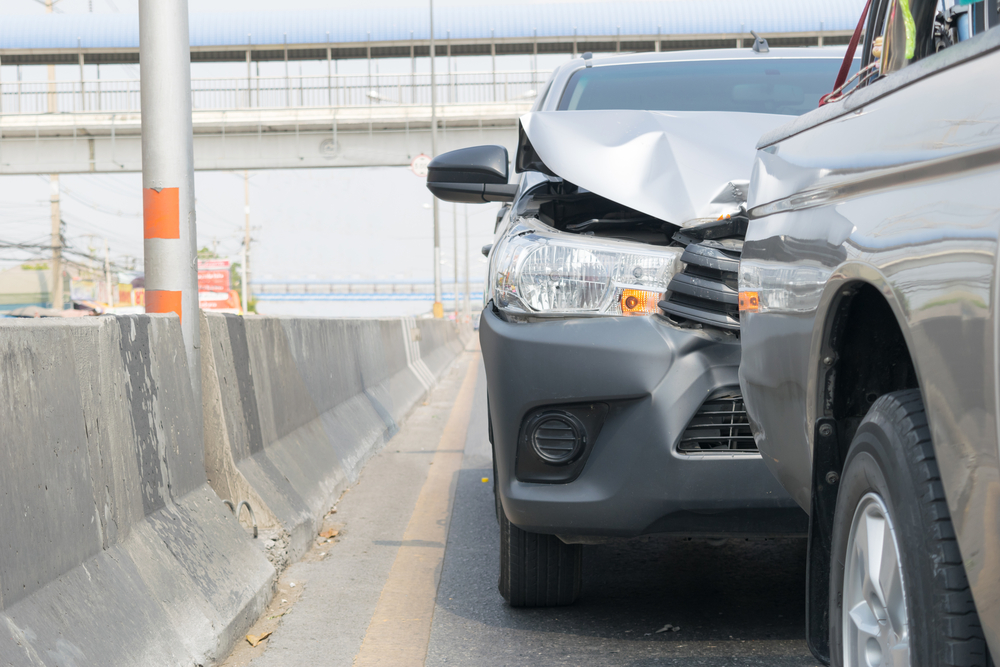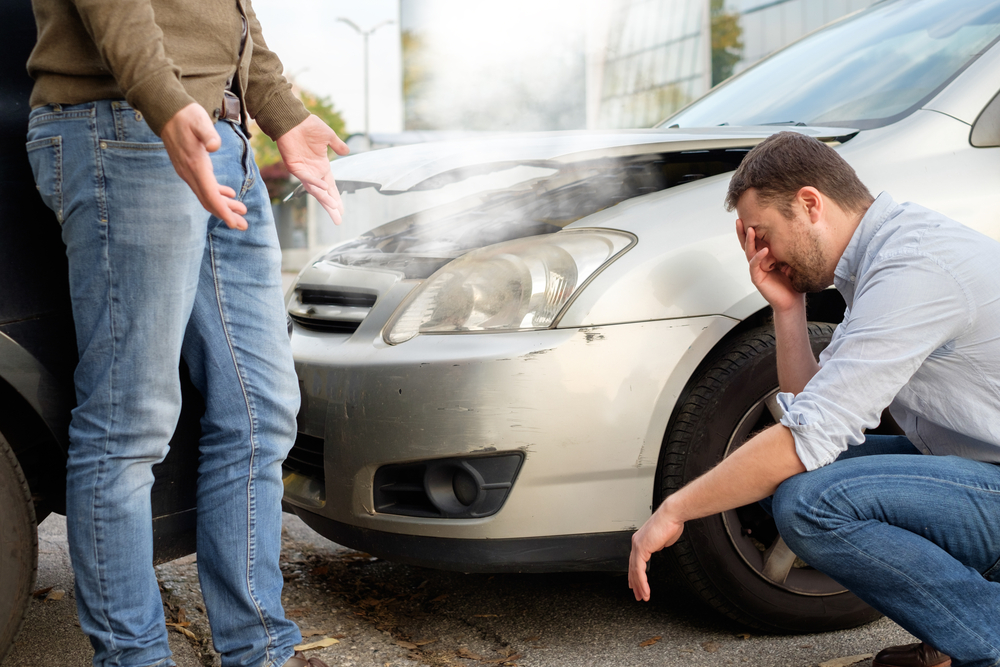In a rear-end accident scenario, the rear driver is usually at fault. If you suffered injuries when someone hit you from behind, you can generally pursue financial compensation from that driver’s insurance company for your accident-related losses.
However, like most accidents, the rear driver may not have caused the crash. These cases can become challenging when you have serious injuries and liability is in dispute.
An experienced car accident lawyer in Calgary can file a timely personal injury claim on your behalf, negotiate with the settlement adjuster, or, if necessary, pursue litigation in court.
Common Causes of Rear-end Accidents
Rear-end car accidents – a prevalent type of collision – occur for various reasons, including the negligence of other motorists.

Distracted driving stands out as a leading cause, with drivers frequently engaging in activities like texting, adjusting controls, or daydreaming instead of focusing on the road ahead. This diversion from the primary task of driving can result in delayed reaction times and an increased likelihood of rear-end collisions.
Tailgating or following another vehicle too closely is another significant contributor to rear-end accidents. Drivers who fail to maintain a safe following distance compromise their ability to react promptly to sudden stops or traffic slowdowns.
This behaviour often leads to a domino effect, causing a chain reaction of collisions in which many drivers and passengers suffer injuries.
Reduced visibility and slippery road surfaces can also make it challenging for drivers to maintain control of their vehicles, increasing the risk of collisions. In such conditions, it becomes crucial for other drivers to adjust their speed and maintain a safe distance from the vehicle in front.
Finally, some rear-end accidents occur when other people drive while they are under the influence of alcohol or drugs. Alcohol is a depressant, and as such, it can slow down a driver’s mental functioning – and significantly delay their reaction time.
Consequently, an intoxicated driver cannot react quickly enough to an abrupt traffic slowdown or apply their brakes in time to avoid a collision. Similarly, drug and alcohol intoxication may delay a driver’s reflexes, making them physically incapable of stopping in time to avoid a crash.
If you suffered injuries in a rear-end accident that another driver caused, a skilled car accident lawyer in your area can promptly investigate your accident circumstances and pursue the financial recovery you need.
Suffering Injuries in a Rear-end Collision
Rear-end car collisions can result in numerous injuries, varying in severity based on the speed of the crash, the size of the vehicles involved, and the use of safety features.
Whiplash is one of the most common injuries in rear-end accidents. It occurs when the accident victim’s head suddenly jolts forward and then snaps back, straining the neck’s soft tissues. Symptoms may include neck pain, stiffness, headaches, and, in some cases, long-term complications.
Back injuries are also common, often affecting the spine, discs, or muscles. Herniated discs, fractures, and sprains can result from the crash, causing pain, limited mobility, and potential long-term complications. The force exerted in a rear-end collision can also lead to a compression of the spine, causing serious injuries.
Head injuries, including concussions and traumatic brain injuries, may happen when the accident victim’s head strikes a hard surface or experiences rapid acceleration and deceleration. Even in seemingly minor collisions, the brain can sustain injuries, often leading to symptoms like dizziness, headaches, or cognitive impairments.
Chest injuries are also common in rear-end collisions, especially when airbags deploy. The force of the collision may cause rib fractures, contusions, or injuries to internal organs. These injuries may require medical attention and can have lasting effects on an individual’s health.
In addition, soft tissue injuries such as bruises, lacerations, and contusions can occur due to the collision – or because of contact with objects inside the vehicle. Airbag deployment, while crucial for safety, can also cause abrasions and bruising.
Psychological injuries, such as post-traumatic stress disorder (PTSD), are often overlooked but can have a profound effect on an accident victim’s well-being. The emotional trauma resulting from a rear-end collision may lead to anxiety, depression, or a heightened fear of driving.
If you suffered any of these injuries in a rear-end accident, a knowledgeable car accident lawyer can handle the legal components of your case while you attend medical appointments and recover.
Proving that the Other Driver Caused Your Rear-end Accident
If you can demonstrate that the rear driver caused your motor vehicle collision, you may be eligible for monetary compensation from the driver’s insurance company.

Establishing negligence involves demonstrating several key legal elements in a rear-end car crash case. Negligence is a legal concept that forms the basis for personal injury claims, requiring the injured party (or plaintiff) to prove that the actions of the other driver (or defendant) fell below a reasonable standard of care.
Here are the essential elements to establish negligence in a rear-end car collision:
- Duty of Care – The plaintiff must show that the defendant owed them a duty of care. In the context of a rear-end collision, this duty typically involves following traffic laws, maintaining a safe following distance, and driving responsibly.
- Breach of Duty – The plaintiff must demonstrate that the defendant breached their duty of care. In a rear-end collision, this breach often involves the failure to maintain a safe following distance, driving too fast for road conditions, or engaging in distracted driving activities.
- Causation – There must be a direct link between the defendant’s breach of duty and the plaintiff’s injuries. In a rear-end collision, this involves proving that the defendant’s actions directly caused the accident and subsequent injuries.
- Proximate Cause – The plaintiff must establish that the defendant’s actions were a proximate cause of the injuries, meaning that the injuries were a foreseeable consequence of the defendant’s breach of duty.
- Damages – Finally, the plaintiff must prove that they suffered damages due to the rear-end collision. Damages may include lost income, inconvenience, and pain and suffering.
By satisfying these necessary legal elements of negligence, the accident victim strengthens their personal injury case and increases their likelihood of obtaining a successful outcome in their claim or lawsuit.
What Should You Do if the Negligent Rear Driver was Uninsured or Underinsured?
Uninsured and underinsured motorist (UM/UIM) claims become crucial following a rear-end car accident when the at-fault driver lacks adequate insurance coverage to compensate the injured party.
These claims serve as a safety net for victims, allowing them to seek compensation when the responsible party’s insurance falls short or is entirely absent.
In a rear-end collision, if the at-fault driver is uninsured, the injured party can file an uninsured motorist claim with their own insurance provider. This coverage provides compensation for various losses when the responsible driver lacks insurance. In this case, the injured party essentially relies on their own insurance policy to cover the damages associated with the accident.
Similarly, underinsured motorist coverage comes into play when the at-fault driver’s insurance is insufficient to cover the full extent of the accident victim’s damages. After a rear-end collision caused by an underinsured driver, the injured party can file an underinsured motorist claim with their own insurance company.
This coverage bridges the gap between the at-fault driver’s insurance limit and the total amount of damages up to the policy limits of the injured party’s underinsured motorist coverage.
When pursuing uninsured or underinsured motorist claims, the injured party must follow specific steps:
- Prompt Notification – Notify your insurance company promptly about the accident and the uninsured or underinsured status of the at-fault driver. Most policies require timely reporting of such incidents.
- Document the Accident – Collect evidence such as police reports, witness statements, and photographs to support your claim. This documentation is valuable in proving fault and demonstrating the extent of your injuries and damages.
- Medical Records – Provide comprehensive medical records detailing your injuries in your rear-end collision. This documentation strengthens your claim for compensation for medical expenses and other related costs.
- Cooperate with the Insurer – Work closely with your insurance company during the claims process. This may involve providing statements, attending medical evaluations, and cooperating with their investigation.
- Legal Assistance – A lawyer with experience handling uninsured and underinsured motorist claims can navigate the legal complexities and advocate for your rights.
Uninsured and underinsured motorist claims offer a vital safety net for individuals involved in rear-end collisions caused by inadequately insured or uninsured drivers.
These provisions ensure you can still pursue compensation and recover for your losses even if the at-fault party’s insurance coverage is insufficient or nonexistent.
When Should You Accept a Settlement Offer after a Rear-end Accident?
Accepting or rejecting a settlement offer from the insurance company following a rear-end car crash requires careful consideration of various factors to ensure fair compensation for damages incurred.
When evaluating a settlement offer, it’s essential to weigh the following key considerations:
- Extent of Injuries – Assess the full extent of your injuries and their overall effect on your life. If your injuries are severe and ongoing, the initial settlement offer may not adequately cover your future needs.
- Lost Wages – If the rear-end collision resulted in missed work or reduced earning capacity, factor in lost income when evaluating the settlement offer. Ensure that the compensation accounts for both current and future income losses.
- Pain and Suffering – Consider the physical and emotional toll of the accident. Pain and suffering, emotional distress, and a diminished quality of life are intangible losses that your lawyer should factor into the settlement calculation.
- Liability and Fault – Clarify the question of liability. If it is clear that the other driver was at fault for the rear-end collision, you may have a stronger negotiating position.
- Insurance Policy Limits – Be aware of the at-fault driver’s insurance policy limits. If the settlement offer is close to or at the policy limit, accepting it may be reasonable. However, if your damages exceed these limits, you may need to explore additional avenues for compensation, such as your underinsured motorist coverage.
- Legal Advice – Consult with a lawyer who has experience in personal injury law. They can provide valuable insights into the fairness of a settlement offer, explain your rights, and guide you on whether to accept or reject the offer, given the overall facts and circumstances of your car accident case.
Ultimately, the decision to accept or reject a particular settlement offer depends on a thorough assessment of your losses, future needs, and the overall fairness of the compensation. If in doubt, seeking legal advice can empower you to make an informed decision and pursue fair reparation for the effects of your rear-end car crash.
What Happens During Car Accident Litigation?
Rear-end car accident cases may proceed to litigation if the at-fault driver’s insurer denies fault for the accident or the insurance company refuses to offer significant monetary compensation.
In litigation following a rear-end car crash, the legal process unfolds to determine liability and seek compensation. Typically, the accident victim’s lawyer initiates the lawsuit against the driver responsible for the rear-end collision.
A lawyer will also introduce evidence in the case, including police reports, witness testimony, and medical records, to establish fault and assess damages.
During the litigation process, both parties may negotiate or opt for alternative dispute resolution methods like mediation. If the parties still cannot reach a middle ground, the case proceeds to trial, where lawyers present arguments, and a judge or jury decides the outcome.
Litigation aims to ensure a fair resolution to the case, hold the at-fault party accountable for the consequences of the rear-end collision, and make the accident victim whole again as much as possible.

Speak with a Local Car Accident Lawyer Today about Your Legal Options
If you recently suffered injuries in a rear-end collision, an experienced car accident lawyer in your area can pursue the financial recovery you deserve.
Your lawyer can investigate the accident, file a claim on your behalf, negotiate with insurance company representatives, and pursue timely litigation if necessary.
Best of all, your Calgary personal injury lawyer can do this for you while you focus on what is important: recovering from your injuries.
